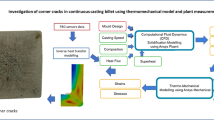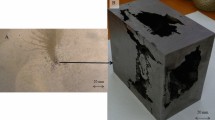Abstract
The formation and propagation of the popular off-corner subsurface cracks in bloom continuous casting were investigated through thermo-mechanical analysis using three coupled thermo-mechanical models. A two-dimensional thermo-elasto-visco-plastic finite element model was developed to predict the mould gap evolution, temperature profiles and deformation behavior of the solidified shell in the mould region. Then, a three-dimensional model was adopted to calculate the shell growth, temperature history and the development of stresses and strains of the shell in the following secondary cooling zones. Finally, another three-dimensional model was used to analyze the stress distributions in the straightening region. The results showed that the off-corner cracks in the shell originated from the mould owing to the tensile strain developed in the crack sensitive regions of the solidification front, and they could be driven deeper by the possible severe surface temperature rebound and the extensive tensile stress in the secondary cooling zone, especially upon the straightening operation of the bloom casting. It is revealed that more homogenous shell temperature and thickness can be obtained through optimization of mould corner radius, casting speed and secondary cooling scheme, which help to decrease stress and strain concentration and therefore prevent the initiation of the cracks.
Similar content being viewed by others
Abbreviations
- A :
-
Constant related to effective strain, s−1
- C eff :
-
Effective specific heat including solidification latent heat of steel, J • kg−1 • °C−1
- C p :
-
Specific heat at constant pressure, J • kg−1 • °C−1
- C w :
-
Specific heat of water,J• kg−1• °C−1
- E :
-
Temperature dependent Young’s modulus
- f s :
-
Solid fraction
- fα:
-
Solid fraction of αphase
- f δ :
-
Solid fraction of δ phase
- f γ :
-
Solid fraction of γphase
- f ZST :
-
Solid fraction at zero strength temperature
- h :
-
Strand thickness, m
- h s :
-
Integrated heat transfer coefficient at strand surface, W • m−2 • °C−1
- k :
-
Temperature dependent thermal conductivity of steels, W • m−1 • °C−1
- K :
-
Strength coefficient
- K T :
-
Boltzmann’s constant, W • m−2 • °C−4
- L :
-
Local distance to meniscus, m
- L f :
-
Solidification latent heat, kJ • kg−1
- L m :
-
Effective length of mold, m
- m :
-
Constant related to strain-rate sensitivity
- m w :
-
Water flowrate for mould cooling, kg • s−1
- n :
-
Strain-hardening exponent
- \(\bar q\) :
-
Average heat flux in mold zone, J • m−2 • s−1
- Q :
-
Activation energy for deformation, kJ • mol−1
- q o :
-
Surface heat flux, J • m−2 • s−1
- R :
-
Gas constant, 8•314 J • mol−1 • K−1
- S eff :
-
Effective area of mould, m2
- ΔT:
-
Temperature difference of mould cooling water, °C
- t :
-
Time, s
- T :
-
Temperature, °C
- T 0 :
-
Local surface temperature of strand, °C
- T a :
-
Ambient temperature, °C
- T m :
-
Casting temperature, °C
- T ws :
-
Temperature of cooling water, °C
- v :
-
Casting speed, m • min−1
- w :
-
Secondary cooling water density, L • m−2 • s−1
- W :
-
Strand width, m
- x :
-
Coordinate along width direction, m
- y :
-
Coordinate along thickness direction, m
- ε:
-
Effective strain
- εp:
-
Effective plastic strain
- εδ:
-
Strain of δ phase
- εγ:
-
Strain of γ phase
- σ:
-
Flow stress, MPa
- B:
-
Blackness
- β:
-
Constant related to flow stress, MPa−1
References
J. K. Brimacombe, K. Sorimachi, Metall. Trans. B 8 (1977) 489–505.
J. K. Brimacombe, E. B. Hawbolt, F. Weinberg, Can. Metall. Quart. 19 (2013) 215–227.
B. Stewart, M. Mcdonald, M. Hopkins, Metall. Italiana 31 (2009) 55–62.
J. Fu, F. Zhang, Y. Zhou, J. Univ. Sci. Technol. Beijing 16 (1994) 315–319 (in Chinese).
J. K. Park, B. G. Thomas, I. V. Samarasekera, Ironmak. Steelmak. 29 (2002) 359–375.
Y. Meng, B. G. Thomas, Metall. Mater. Trans. B 34 (2003) 685–705.
H. N. Han, Y. G. Lee, K. H. Oh, D. N. Lee, Mater. Sci. Eng. A 206 (1996) 81–89.
Y. Ueshima, S. Mizoguchi, T. Matsumiya, H. Kajioka, Metall. Trans. B 17 (1996) 845–859.
T. W. Clyne, M. Wolf, W. Kurz, Metall. Trans. B 13 (1982) 259–266.
K. H. Kyung, Y. J. Tae, O. K. Hwan, L. D. Nyung, ISIJ Int. 36 (1996) 284–289.
H. Sun, J. Zhang, Metall. Mater. Trans. B 45 (2014) 1133–1149.
K. Liu, Q. Sun, J. Zhang, C. Wang, Metall. Res. Technol. 113 (2016) 504.
D. P. Tan, Y. S. Ni, L. B. Zhang, J. Iron Steel Res. Int. 24 (2017) 669–677.
J. K. Brimacombe, I. V. Samarasekera, R. B. Mahapatra, in: K. Matsumoto, Y. Hoshijima, K. Ishikura (Eds.), The Sixth International Iron and Steel Congress, The Iron and Steel Institute of Japan, Nagoya, 1990, pp. 246–255.
J. K. Brimacombe, Can. Metall. Quart. 15 (1976) 163–175.
J. K. Park, B. G. Thomas, I. V. Samarasekera, Ironmak. Steelmak. 29 (2002) 359–375.
R. Saraswat, D. M. Maijer, P. D. Lee, K. C. Mills, ISIJ Int. 47 (2007) 95–104.
Y. M. Won, T. J. Yeo, J. S. Dong, K. H. Oh, Metall. Mater. Trans. B 31 (2000) 779–793.
A. Jablonka, K. Harste, K. Schwerdtfeger, Steel Res. Int. 62 (1991) 24–33.
Y. Meng, B. G. Thomas, Metall. Mater. Trans. B 34 (2003) 685–705.
J. Miettinen, S. Louhenkilpi, Metall. Mater. Trans. B 25 (1994) 909–916.
Y. M. Won, B. G. Thomas, Metall. Mater. Trans. A 32 (2001) 1755–1767.
H. Mizukami, K. Murakami, Y. Miyashita, Tetsu-to-Hagane 63 (1977) S652 (in Japanese).
M. Uehara, I. V. Samarasekera, J. K. Brimacombe, Ironmak. Steelmak. 13 (1986) 138–153.
Z. Z. Cai, M. Y. Zhu, Int. J. Miner. Metall. Mater. 21 (2014) 240–250.
Author information
Authors and Affiliations
Corresponding author
Rights and permissions
About this article
Cite this article
Li, Yj., Li, H., Lan, P. et al. Thermo-elasto-visco-plastic finite element analysis on formation and propagation of off-corner subsurface cracks in bloom continuous casting. J. Iron Steel Res. Int. 24, 1159–1168 (2017). https://doi.org/10.1016/S1006-706X(17)30168-1
Received:
Revised:
Accepted:
Published:
Issue Date:
DOI: https://doi.org/10.1016/S1006-706X(17)30168-1




